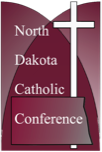Reflections on My Visit to the White House to See Pope Benedict XVI
by Christopher Dodson
Executive Director
North Dakota Catholic Conference
June 2008
It seemed like an odd way to receive an invitation to the White House -- an e-mail message with no mention of my name or the time of the event. But a little research revealed the invitation's legitimacy. I had received an invitation to the arrival ceremony for Pope Benedict XVI during his historic visit to the United States.
The event took place on the White House south lawn on a beautiful spring day. The White House issued different types of tickets with different seating or standing assignments and different entry times. We had to arrive early. Government security had to clear an estimated 12,000 people for one of the largest events in White House history.
The size of the crowd gave me mixed feelings. On the one hand, the large numbers of invitees reflected the significance of the event and the importance President Bush placed on this second-ever visit of a pope to the White House. On the other hand, would I be able to see anything in the midst of such a large crowd? As it turned out, I had "center seated viewing," which meant not only that I had a seat, but also that it was on a bleacher. I did not have to strain to see over people in front of me. Most of the attendees -- including the bishops -- had to stand for the event and the two or so hours prior.
It seemed as though the White House pulled out all the stops for this official state visit. A full color guard, the Marine Band, the Army Chorus, the Old Guard Fife and Drum Corps, and a host of dignitaries greeted the Holy Father. The crowd waved papal and U.S. flags. The band played the national anthems of both the Holy See and the United States, joined by a 21-gun salute. Kathleen Battle, a soprano from Ohio, sang the Lord's Prayer, accompanied only by a harp that shone in the spring sunshine.
The President welcomed Pope Benedict, acknowledging him as the successor to the "Chair of Saint Peter." He spoke of how we need the Holy Father's message that God is love, that all human life is sacred, that we need to embrace a culture of justice and truth, and that true liberty requires us to live our freedom "not just for ourselves, but in a spirit of mutual support."
The Holy Father praised the United States' commitment to moral truths, religious belief, and freedom to worship. Invoking George Washington and Pope John Paul II, he spoke of the importance of liberty in addressing injustice here and abroad and how true liberty must always be rooted in religious and moral truth. He finished with a jubilant "God bless America." It was, as the President was overhead to say, an "awesome speech."
Three musical parts of the ceremony stood out for me. First was the Old Guard Fife and Drum Corps. This small unit with instruments and uniforms from the colonial period presented the "troop in review" for the Holy Father. It was simple, majestic, and very moving. The Army Chorus concluded the official ceremony with a rendition of the "Battle Hymn of the Republic." The stirring choir, the joyful singing of the crowd, and the waving of hundreds of U.S. and Papal flags combined for an unforgettable moment.
Following the official ceremony, the President and Pope Benedict walked up to the balcony. The band and choir then led the crowd of thousands in singing "Happy Birthday" to the Holy Father, who turned 81 that day. The pope seemed touched.
Looking out from White House balcony, beyond the dignitaries, bishops, bands, and thousands of onlookers waving flags of red, white, and blue, and gold and white, Pope Benedict would have seen the Washington Monument.
In 1854, the monument was only partially constructed when Pope Pius IX sent a 2000 year-old marble block as gift to aid its construction. Anti-Catholic sentiment at the time was so intense that a gang stole and destroyed the block. An anti-Catholic group immediately took control of the organization overseeing the monument's construction, intent on making sure that "papists" did not stain the American monument. Funding and progress on the monument stopped and was not resumed until 1879. To this day, visitors can see a difference in color between the blocks erected before and after 1854. That "color line" stands as a permanent reminder of the ugly anti-Catholicism in our nation's history.
Now, less than one-half mile from that scene of past intolerance, I watched the successor of Peter receive an unprecedented welcome from the President of the United States before an enthusiastic crowd of thousands. I felt blessed to be a Catholic. I felt proud to be an American.
What We Do
The North Dakota Catholic Conference acts on behalf of the Roman Catholic bishops of North Dakota to respond to public policy issues of concern to the Catholic Church and to educate Catholics and the general public about Catholic social doctrine.

Contact Us
North Dakota Catholic Conference
103 South Third Street, Suite 10
Bismarck, North Dakota
58501
1-888-419-1237
701-223-2519
Contact Us

